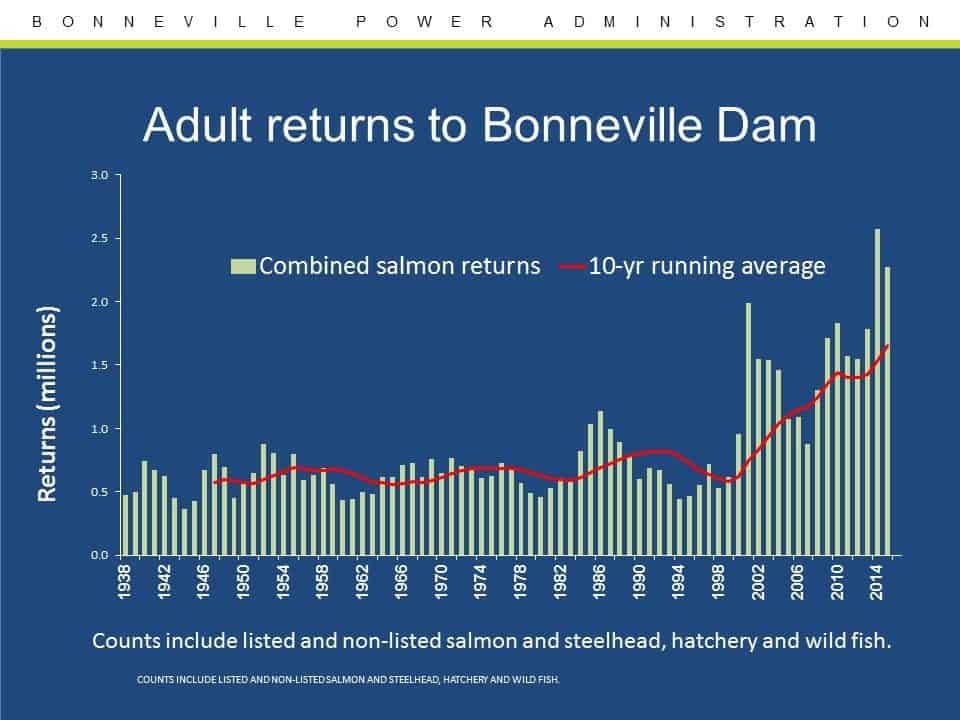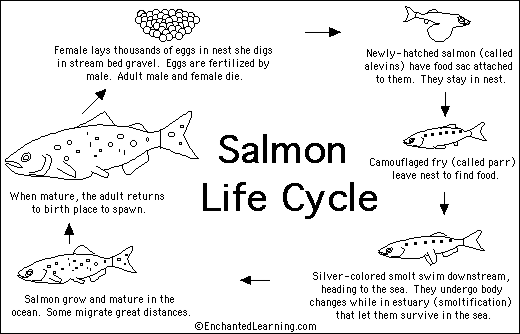A balanced approach to recovery
In the Columbia River Basin, there are 13 species of salmon and steelhead listed as threatened or endangered under the Endangered Species Act. Four of these are Snake River runs.
The ESA listings have been in place for many years, following decades of decline in fish populations.
“Recovery plans have been proposed, biological opinions issued and re-issued, and legal battles fought over what actions, proposed and implemented, should be taken to avoid further jeopardizing the listed species, especially salmon and steelhead directly affected by hydropower dams,” wrote John Harrison, public information officer for the Northwest Power and Conservation Council.
All previous recovery plans have met legal challenge. Most recently, federal agencies were defending the 2014 biological opinion (or BiOp). In May 2016, Judge Michael Simon of the U.S. District Court for Oregon ruled that a comprehensive environmental impact statement must be completed for the 2014 BiOp and should include evaluation of alternatives like breaching mainstem dams. While his ruling kept the current BiOp in place, it also required a new one to be completed by September 2021.
The issue of dam breaching has been examined before. For example, in 2002 the US Army Corps of Engineers completed an EIS on the four lower Snake River dams, evaluating alternatives to help lower Snake River fall Chinook pass the dams. The Corps found dam breaching by itself would not recover the ESA-listed fish, would take the longest time to benefit the fish and would be the most uncertain alternative to implement.
The Port of Lewiston supports a balanced approach to maintaining the Columbia Snake River System for its numerous benefits and recovering populations of historic fish. Our region should continue pursing aggressive and effective fish strategies but dams and fish recovery are not mutually exclusive.
The current BiOp, which will continue to guide recovery until 2021, was developed over many years by Republican and Democratic administrations, three lead federal agencies, states and tribes. Additionally, numerous stakeholders with wide-ranging interests and goals have actively engaged in the process, sometimes for more than two decades. Data from recent fish runs indicate that the fish passage solutions at dams, and habitat and hatchery programs in the BiOp are working.
The river system provides many benefits to our region and our world. The value of those benefits will only continue to grow as our world works to reduce CO2 emissions.
River navigation and hydropower help keep our air clean, our environment healthy and our local economy moving forward. Barging moves far more product and requires far less fuel than road or rail. Hydropower results in zero CO2 emissions and supports development and implementation of new sustainable energy resources, such as wind and solar.
Furthermore, the river system provides outstanding recreational opportunities, and, here locally, plays an important role in our sense of place. Lewiston, Idaho, is well-known as Idaho’s Only Seaport.
Both the fish and a thriving multi-use river system are intrinsic to the lives and livelihood of people in the Pacific Northwest. We want to leave a legacy of both economic growth and salmon recovery.
There are numerous resources regarding fish recovery in the Pacific Northwest. On this page, the Port of Lewiston strives to provide as many resources as possible and a jumping off point for further research.

navigation
2016 Comprehensive Evaluation
Read the 2016 Comprehensive Evaluation to get the full story on what’s being done to protect salmon and steelhead in the Columbia River Basin.
History of Salmon Recovery
Read the following article for a comprehensive history of Salmon Recovery.
Salmon Recovery and the Guiding Biological Opinion
A few key resources regarding Salmon Recovery and the guiding Biological Opinion:
- Federal Columbia River Power System Biological Opinion
- CRSO EIS Process: Current effort to evaluate a range of alternatives for long-term system management
- May 2016 opinion by Judge Michael Simon
- 2002 USACE Lower Snake River EIS
- Federal Caucus: salmonrecovery.gov
- Columbia Basin Fish & Wildlife Program
- Endangered Species Act
Additional Resources
Northwest River ParTners
- Dollars & Sense: Analysis of DamSense Claims About the Lower Snake River Dams (July 2021)
- DEIS One-Page Summary (March 2020)
- 2021 Fast Facts Reference Guide
- Return of Deadly Marine Heat Wave Underscores Critical Role of Carbon-Free Hydropower Energy (September 2019)
- In Response to the ECONorthwest Study-Lower Snake River Dams: Economic Tradeoffs of Removal (August 2019)
- Adult Returns To Bonneville Dam (1938 to 2016)
- Opinion Article on May 2016 Court Ruling from NWRP Executive Director Terry Flores (May 2014)
- Salmon and Hydropower: A Power System to Keep Salmon Safe (March 2015)
- Salmon Recovery: Dams Are an Easy Scapegoat, by Terry Flores (2014)
- Fish Runs Improving, Families and Businesses Invest Millions (March 2014)
- Snake River Dams: Valuable Assets(October 2014)
- Salmon Basics (October 2014)
- Salmon for Harvest (October 2014)
- ESA Fact Sheet (October 2014)
Pacific Northwest Waterways Association
- Water Resources Development Act (WRDA)
- Columbia Snake River System Facts
- Inland Waterways Trust Fund
- Columbia Snake River System Investments & Accomplishments
- Columbia River Basin Restoration Act
- CRSO 2020 Fact Sheet (March 2020)
- Commentary: Snake River dams--Setting the record straight (May 6, 2019)
- PNWA Executive Director Kristin Meira testifies at House Transportation & Infrastructure Hearing (February 7, 2019)
- PNWA Responds to Vulcan/ECONorthwest (2019)
- Snake River Dams – The Facts (2017)
- BiOp Lawsuit (2016)
- Snake River Dams Fact Sheet (2016)
- Benefits of Snake River Dams (2016)
- PNWA Presentation to the LC Valley(April 6, 2016)
Bonneville Power Administration
- BPA Facts
- BPA Pocket Facts
- BPA Committed to NW Values
- Economic Benefits
- Hydropower in the Northwest
- Fact Sheet: Power from the Willamette Basin Dams (August 2019)
- How BPA Spends a Dollar of its Power Revenues (Updated: July 25, 2019)
- Fact Sheet: The Carbon-Free Footprint of BPA's Hydropower Supply (January 2019)
- Fact Sheet: BPA Invests in Fish and Wildlife (January 2019)
- Fact Sheet: Regional Power Benefits of the lower Snake River dams (March 2016)
- Salmon and Steelhead
US Army Corps of Engineers
- Fact Sheet: John Day Lock and Dam
- Fact Sheet: The Dalles Lock and Dam
- Fact Sheet: The Bonneville Lock and Dam
- Fact Sheet: Columbia River Projects
- How to Lock Through
- January 2019 CRSO Fact Sheet (Walla Walla District Corps of Engineers, 2019)
- Corps of Engineers Water Resource Projects Authorities Overview (Walla Walla District Corps of Engineers, 2019)
- Spillway Weirs: Celebrating 10 Years of Service to the Nation (Intercom Magazine, Dec. 2015)
- Snake River Dams: Providing Outstanding Value to the Nation(Intercom Magazine, Dec. 2015)
- A Year of Record Fish Returns(Intercom Magazine, Oct. 2014)
- Corps Focusing on Fish Recovery (Intercom Magazine, June 2014)
- Walla Walla District Intercom Magazines
- Walla Walla District Fish Programs
- Fish Counts & Reports
Other
- Where Salmon Die, By John McKern (2015)
- The Case Against Breaching the Four Lower Snake River Dams to Recover Wild Snake River Salmon, By John McKern (2016)
- The Snake River Dams: Analysis of Cost Claims, By Dennis Wagner for CEDER (June 2015)
- Protected Marine Mammals Take Unknown Toll on Spring Chinook Salmon (Lewiston Tribune article, Feb. 27, 2015)

